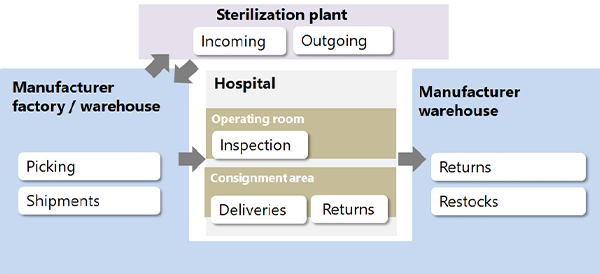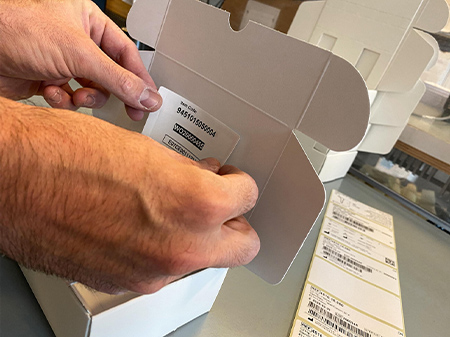Feb 18, 2021
SATO, a global pioneer in the development of auto-ID and labeling solutions, has built an end-to-end supply chain solution for Italy-based orthopedic implant manufacturer LimaCorporate. The solution, comprising hardware, software and tags, centers around SATO’s next generation PJM RFID technology for source tagging of implantable products prior to both gas and radiation sterilization, enabling a new streamlined workflow not possible using barcodes or conventional RFID products.
 Touchpoints requiring scans
Touchpoints requiring scans
Orthopedic implants — artificial replacements for joints, bones, or cartilage to address damage or deformity are made in many sizes to suit the wide range of human body types. Since the correct size often remains unknown until surgery, manufacturers may supply several hundreds of implant parts in advance, based on patient data. Yet only a few of these are actually used, and the rest are returned, resulting in a labor intensive process. Each supply chain touchpoint — picking products, shipping, receiving, returning after surgery, and restocks for unused products — involves a scan of every item to accurately understand what is in stock. Multiply this task into the thousands for just a single shipment.
As the health care sector adopts Industry 4.0 practices, source tagging with RFID is essential for streamlining logistics and warehousing to improve supply chain visibility and productivity. However, conventional RFID products face a significant drawback — they cannot withstand the radiation sterilization process which erases or corrupts their memory. LimaCorporate selected PJM RFID from among the range of RFID products SATO handles because of its next generation chip with the ability to withstand, electron beam and gamma ray sterilization.
Source tagging of implants with PJM RFID removes the need for retagging at various touchpoints, enabling faster inspections, reconciliation of kits and stock rotations, with end-to-end visibility from the factory to the operating room. Furthermore, source tagging with RFID can help meet medical device labelling reporting1 and identification2 compliance requirements and bring quality control benefits of smart traceability and real-time post market surveillance.
 Application of SATO PJM RFID tags
Application of SATO PJM RFID tags
SATO conducted a successful pilot for LimaCorporate in late 2018, demonstrating the potential for a 50 percent increase in productivity with a PJM RFID tunnel reader-based system3. LimaCorporate has since begun to apply radiation-hardened tags inside the packaging of its products during the production process before sterilization to streamline its production logistics and distribution.
“We built a sterilization hardened tag, which was key for LimaCorporate,” exclaimed Kevin Allart, global head of healthcare at SATO. "We provided a total qualified solution with PJM hardware, bespoke software and PJM RFID tags, aiming for a seamless integration into the customer’s ERP system. We aimed for something deeper than just a supplier to end user relationship, and I am excited that this gave birth to a cutting-edge technical partnership.”
The technology adopted by LimaCorporate is also designed to bring numerous benefits to hospitals. The SATO PJM RFID tags are NFC enabled for on-the-fly verification of implants with a smart device on the front lines of care. By managing owned or consigned medical device inventory with fixed-in-place or mobile shelves or cabinets, hospitals can further improve inventory management processes from expiration control of products in the warehouse and verification of received materials.
For more about LimaCorporate, visit its official website or LinkedIn.
- 1FDA Medical Device Reporting (MDR) regulations (21 CFR Part 803) and European Medical Devices Regulation (MDR 2017/745) which govern the safe production and use of medical devices
- 2UDI (Unique Device Identification): A system to assign a unique identifier to medical devices for traceability and safety; currently utilized in US, EU, China, South Korea and Saudi Arabia.
- 3Based on the combination of bulk scanning items, assisting the rebuilding of kits and the integration to the ERP system made possible with PJM tags, tunnel readers and PJM ORBIT™ management solution
About PJM RFID
ISO 18000-3 Mode 2 Phase Jitter Modulation (PJM) RFID is the answer for situations where large volumes of tagged items need to be quickly and accurately identified with 100% accuracy. On top of providing 100% accuracy, PJM RFID was specifically designed to allow tagged items to be stacked or stored in any random orientation in static or dynamic conditions where bulk tagged items are moving at high speed.




